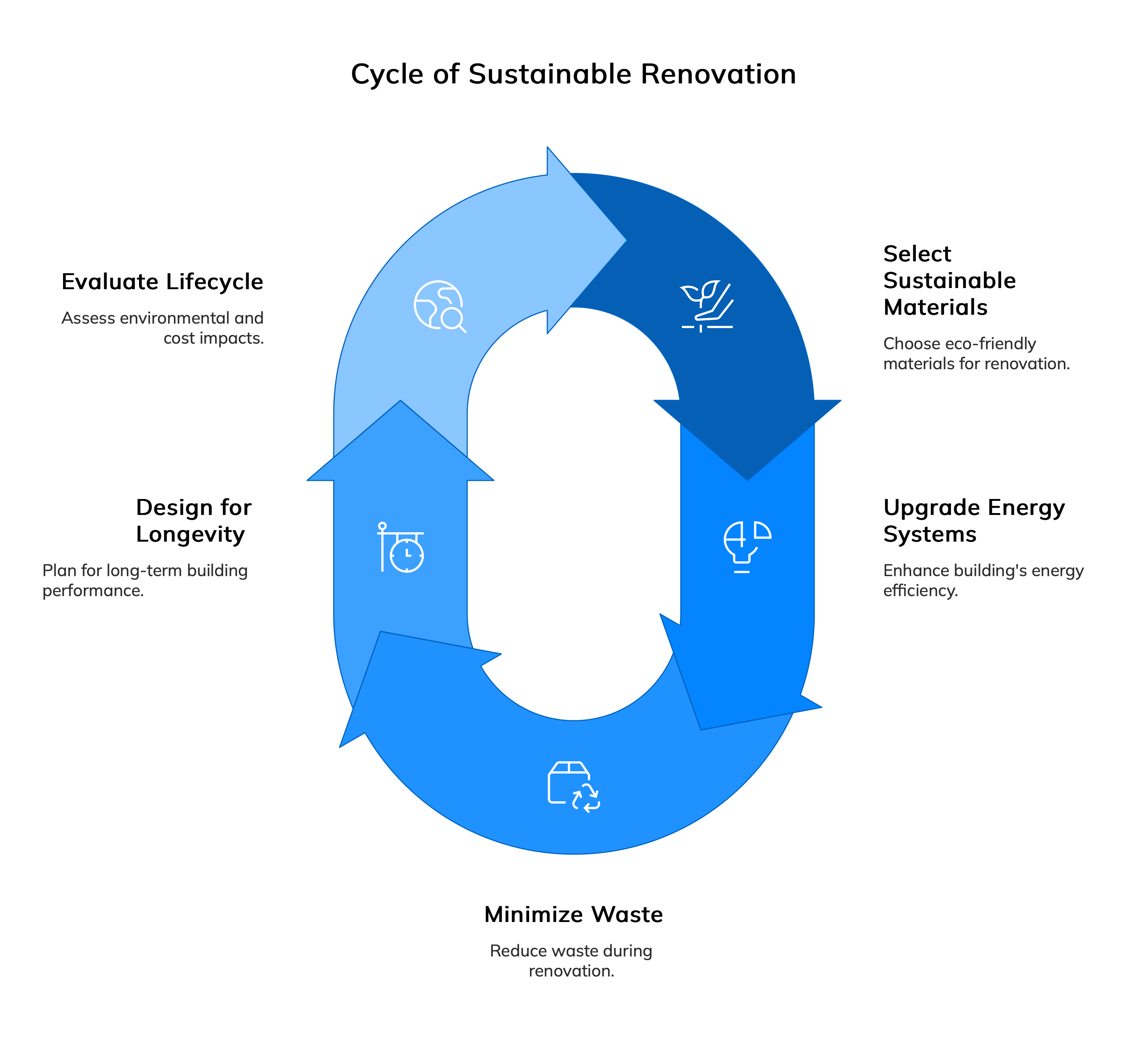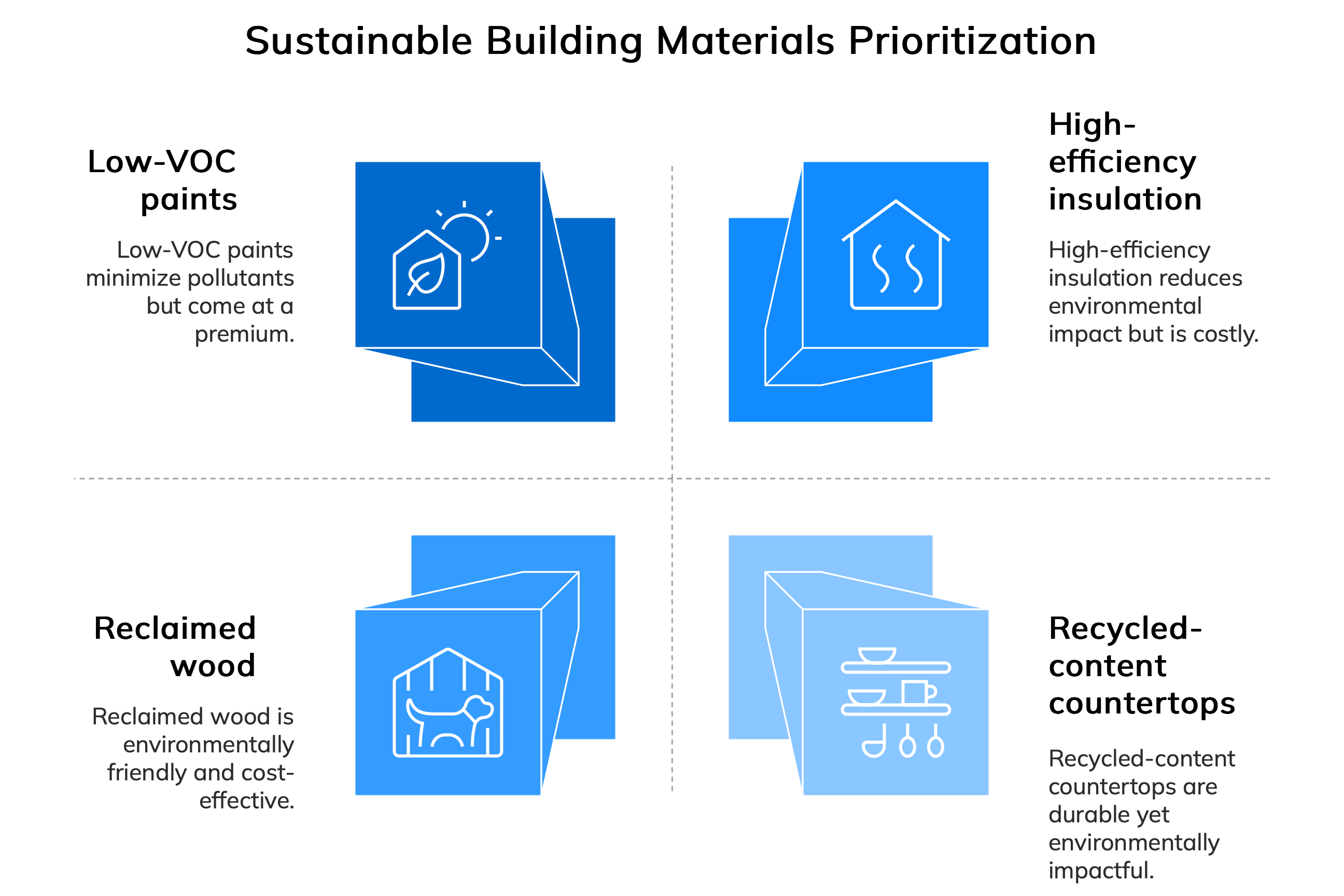You’ve probably already had a client ask this question this year: “Can we do this more sustainably?”
Whether you’re managing residential upgrades or overseeing commercial refurbishments, the question is becoming increasingly common. Sustainability is no longer just a trendy word – it’s now a key consideration for clients trying to future-proof their investments and reduce operational costs. But in an economy where every dollar is scrutinized, the question remains: Is sustainable renovation a smart financial strategy or an expensive gamble that’s hard to justify on the balance sheet?
Let’s unpack the reality of sustainable renovation – what it means for renovation professionals, what materials and solutions actually deliver value, and how project management software plays a pivotal role in making it all work.
Numbers: Did you know that 40% of worldwide carbon emissions are attributed to the construction and renovation of buildings and the energy needed to run them?
The Shift Toward Sustainability in the Renovation Industry
If you’ve been in this business for a while, you know renovation trends come and go. But this shift toward sustainability feels different. It’s not just driven by aesthetics or lifestyle – there’s mounting pressure from regulators, rising utility costs, increasing environmental awareness, and the demand for smarter, healthier buildings.
Clients are more informed than ever. Whether they’re homeowners or commercial property owners, many are actively seeking renovation strategies that reduce their carbon footprint and long-term operating costs. That’s putting the onus on renovation managers to not only deliver quality projects on time and on budget but also to align with these new sustainability expectations.
The catch? Sustainable renovation still carries a reputation – sometimes fair, often exaggerated – for being cost-prohibitive. So let’s look at what makes up a sustainable renovation and whether those concerns hold weight.
What Counts as a Sustainable Renovation?
Sustainable renovation reduces environmental impact while improving a building’s energy efficiency, indoor air quality, and longevity. This usually involves using sustainable renovation materials, upgrading to energy-efficient systems, minimizing waste, and designing for long-term performance.

We’re talking about more than just installing a few solar panels or using recycled tile in a bathroom. True sustainability looks at the entire lifecycle of a renovation – from material sourcing to demolition waste handling – and evaluates long-term cost savings and environmental impact.
You might specify high-performance insulation, select low-VOC finishes, source FSC-certified wood, or recommend triple-glazed windows. Each of these decisions affects sustainability metrics, budgets, schedules, and client expectations.
The Economic Reality: Are Sustainable Renovations Actually Cost-Saving?
It’s easy to see why some clients – or even some project managers – are hesitant. Sustainable materials can be more expensive upfront, and not every payoff is immediate. But framing it as a cost-only conversation misses the bigger picture.
Numbers: Renovating green typically costs between 1% and 12% more than a similar non-green renovation project.
There are very real financial benefits to sustainable renovation. Energy-efficient upgrades, like LED lighting systems, smart HVAC controls, or modern insulation methods, consistently reduce operational costs. The ROI may not come within weeks, but in five or ten years, many of these systems pay for themselves – and then some.
Additionally, sustainable buildings often appraise higher, rent faster, and have lower vacancy rates, particularly in the commercial sector. In residential markets, younger buyers are increasingly willing to pay a premium for homes with green certifications or eco-conscious design.
And let’s not forget about financial incentives. Tax credits, grants, and rebates are increasingly available for projects that use sustainable renovation solutions. These can significantly offset initial costs if planned for in advance.
The key takeaway? Sustainable renovation isn’t inherently more expensive – it just requires better planning and smarter project execution.
Why Planning Is Everything – And How Software Makes It Work
Any renovation project is a balancing act. Managing budgets, schedules, subcontractors, suppliers, compliance requirements, and design elements takes a lot of coordination. When you add sustainable goals to that mix, it increases the complexity.
Choosing the right sustainable renovation materials, calculating their availability, securing eco-certified suppliers, and aligning everything with client expectations requires precision. One missed delivery or miscalculated quote can quickly spiral into delays or cost overruns.
This is where renovation project management software becomes indispensable.
If you’re still managing timelines on spreadsheets, juggling budgets in email threads, or chasing down materials quotes by phone, integrating a platform like RenoQuest can significantly shift your productivity and profitability.
Numbers: 74% of AEC companies are investing in technology to improve sustainability
RenoQuest is explicitly designed for renovation professionals. It allows you to manage every aspect of your project workflow from one place – budgets, schedules, supplier communications, material specs, contractor assignments, and client approvals.
For sustainable renovation projects, having this level of control and organization is even more critical. You’re often working with longer lead times, niche suppliers, and unique certification requirements. RenoQuest helps you keep it all on track, ensuring your sustainable goals don’t get derailed by avoidable delays or miscommunications.
Choosing Sustainable Materials That Actually Perform
Not all “green” materials are created equal. Some live up to the hype, while others are more marketing than impact. For renovation managers, the challenge is sourcing sustainable renovation materials that offer both environmental benefits and long-term performance.
Materials worth considering include:
- Reclaimed wood for flooring, beams, or cabinetry. It adds character, avoids new deforestation, and is often stronger than new lumber.
- Low-VOC paints and adhesives, which reduce indoor air pollutants – a growing concern for health-conscious clients.
- Recycled-content countertops made from glass, concrete, or even paper. They’re durable and divert waste from landfills.
- High-efficiency insulation options, like cellulose or cork, which reduce heating and cooling loads while using renewable resources.

Again, materials alone don’t make a project sustainable. It’s the integration of these elements into a holistic design – and an efficient process – that drives results. With project management software supporting the decision-making and coordination, these complex choices become more manageable and profitable.
Sustainable Renovation Is a Business Opportunity, Not a Burden
Too often, sustainable renovation is framed as a challenge – something that must be accommodated or “sold” to the client. But for those in the renovation business, it’s a growth opportunity.
Clients actively seek contractors and project managers who can bring sustainability to the table without inflating the budget or compromising quality. Firms that can confidently offer sustainable renovation solutions are positioned to stand out in a competitive market, especially as demand continues to shift.
By using tools like RenoQuest to streamline operations, document sustainability metrics, and keep teams aligned, renovation professionals can offer high-performance, environmentally responsible renovations that are financially sound.
The Bottom Line
Sustainable renovation in today’s economy isn’t a gamble – it’s a calculated shift that, when managed well, can be a win-win for both clients and professionals. While upfront costs may occasionally be higher, the long-term benefits – energy savings, healthier buildings, tax incentives, and increased property value – can make the business case compelling.
For those managing renovations as a profession, embracing sustainability isn’t just about doing what’s right for the planet. It’s about staying relevant, delivering more excellent value, and running more innovative, more efficient projects.
And when you’ve got the right renovation project management software, making sustainability part of your process becomes less of a challenge – and more of a competitive advantage.


